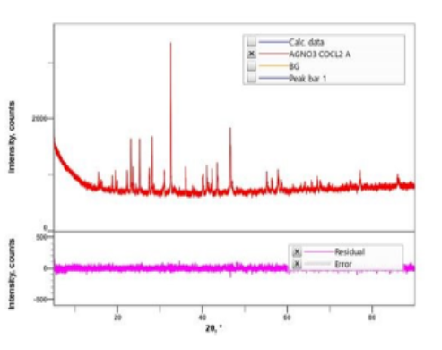


Indian Journal of Science and Technology
Year: 2024, Volume: 17, Issue: 19, Pages: 2013-2023
Original Article
V Logeswari1, S Yamini1, P Pavithra1, A Seethal Papitha2, D Lakshmi3*
1PG Student, Plant Biology and Plant Biotechnology, SDNB Vaishnav College for Women, Chromepet, Chennai, Tamil Nadu, India
2Research Scholar, Plant Biology and Plant Biotechnology, SDNB Vaishnav College for Women, Chromepet, Chennai, Tamil Nadu, India
3Associate Professor, Plant Biology and Plant Biotechnology, SDNB Vaishnav College for Women, Chromepet, Chennai, Tamil Nadu, India
*Corresponding Author
Email: [email protected]
Received Date:21 March 2024, Accepted Date:25 April 2024, Published Date:09 May 2024
Objectives: To biosynthesize, evaluate, and investigate the green synthesis of silver-cobalt bimetallic nanoparticles using red alga Amphiroa sp. and its interactions with human pathogens in a colloidal condition. Methods: The marine red algal extract of Amphiroa sp. was used to synthesize the bimetallic nanoparticles of Ag and Co. For this 50mL of 10-3 aqueous Ag-Co prepared solutions were combined with 50mL of pure algal extract. It was characterized by UV-Vis, FTIR, XRD, and SEM. It was tested for its antioxidant, antibacterial, and cytotoxic activities. The antibacterial activity of bimetallic nanoparticles was tested on five human pathogens Bacillus subtilis, Escherichia coli, Klebsiella pneumoniae, Staphylococcus aureus, and Pseudomonas aeruginosa. The MTT assay method was used for cytotoxic activity for MCF-7 Breast cancer cell lines. Findings: The green synthesized Amphiroa sp. bimetallic nanoparticles showed a UV-Vis spectrum absorption peak at 517nm. Analysis of the FTIR spectra verified the functional groups involved in the production of the Ag-Co nanoparticles. The diffraction pattern of silver-cobalt nanoparticles and the X-ray diffraction pattern of silver nanoparticles showed diffraction angles at 2θ values of 32.5°(15), 46.5°(11) which correspond to (111), (200), and (220). The particle size distribution, which ranges from 56 to 250nm, and the shape was revealed by SEM investigation to be cubic to rhomboidal, thus, they were confirmed to be nanoparticles as well as fine particles/particulate matter. Radical scavenging activity by DPPH, ABTS, and ferrous-reducing power assays were used to investigate the antioxidant potential. The antibacterial activity of bimetallic nanoparticles was tested on five human pathogens and with the zone of inhibition of 23, 18, and 20 mm for Pseudomonas aeruginosa, Escherichia coli and Bacillus subtilis, respectively. The cytotoxic effect was observed on MCF-7 cancer cell lines were evaluated by MTT assay. The IC50 value of our Ag-Co bimetallic sample was found to be 70.90µg/ml at 200µg/mL concentrations. Novelty: Biosynthesizing and investigating Ag-Co bimetallic nanoparticles using red alga and its characterization, antioxidant, antimicrobial and cytotoxic activity.
Keywords: Amphiroa sp.; Ag-Co Bimetallic nanoparticles (BNPs); antioxidant, antibacterial and cytotoxic activity
© 2024 Logeswari et al. This is an open-access article distributed under the terms of the Creative Commons Attribution License, which permits unrestricted use, distribution, and reproduction in any medium, provided the original author and source are credited. Published By Indian Society for Education and Environment (iSee)
Subscribe now for latest articles and news.